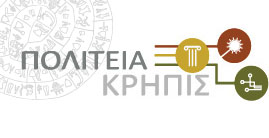The 10th anniversary of “Researchers’ Night” was successfully celebrated at FORTH premises on the 25th of September 2015, attracting more than 1500 visitors of all ages.
A special thematic on research, applications and infrastructures entitled “Cultural Heritage @ FORTH” was organized disseminating the work performed in the framework of KRIPIS-POLITEIA project, as well as the research infrastructures available under the IPERION-CH.gr umbrella.
Presented Activities
- Lasers for Cultural Heritage analysis, diagnosis and conservation:
Laser based systems, developed at IESL-FORTH, for analysis, diagnosis and conservation of artworks and monuments will be presented. Emphasis will be given to videos and photos describing typical examples (IPERION-CH.gr) and in-situ applications (KRIPIS-POLITEIA).
- Laboratory of Geophysical – Satellite Remote Sensing and Archaeo-environment:
Presentation of methodological approaches and results on the implementation of ground, aerial and satellite remote sensing prospection techniques and GIS management of CH monuments and sites in the framework of the KRIPIS-POLITEIA research project. (Ιnstitute of Mediterranean Studies).
- Analysis of ancient DNA. A completely new view of the past:
Can we retrieve DNA from objects found in archaeological excavations such as bones from humans and animals or food residues such as olives and beans? Now, in the first laboratory for analysis of ancient DNA in Greece, which is equipped with specialized and modern technologies (as used in forensic research) we can! With these analyses we can shed light on the origin and migration of populations and for the first time understand in detail how ancient farmers produced and stored food and merchandise. We can open a window to our past.
- The Information System for Cultural Heritage. Exploring the Byzantine World:
Τargeted digital content showcasing the Byzantine culture will be presented. The e-services created within the “Exploring the Byzantine World” project are designed to inform teachers, researchers, schoolchildren and interested members of the general public about monuments, persons, historical events, achievements and aspects of daily life in Byzantium. A set of interactive educational activites that will enable students to discover Byzantium by playing, will also be available. - Reasoning on Virtual Reconstruction:
On-going results of the Marie Curie ITN-DCH project, “Initial Training Network for Digital Cultural Heritage (ITN-DCH): Projecting our Past to the Future” which is the first and one of the largest Marie Curie fellowship projects in the area of the e-documentation / e-preservation and CH protection funded by the European Union under the FP7 PEOPLE research framework. The poster will present virtual reconstruction as the basis for understanding the past both by experts and the general public. It discusses the methodolgy for creating 3D models as accurate representations of a monument or an archaeological site. It proposes an information system that supports argumentation and reasoning on the virtual reconstructions and the 3D models. - Initial Training Network for Digital Cultural Heritage:
Rendering and animation in mobile VR and AR: On-going results of the Marie Curie ITN-DCH project. The “Initial Training Network for Digital Cultural Heritage (ITN-DCH): Projecting our Past to the Future” with acronym ITN-DCH, is the first and one of the largest Marie Curie fellowship projects in the area of the e-documentation / e-preservation and CH protection funded by the European Union under the FP7 PEOPLE research framework. The Project started on the 1st of October 2013 and its consortium comprising of 14 full partners and 8 associate members covering the entire spectrum of European CH actors, ranging from academia, research institutions, industry, museums, archives and libraries. In this demo we illustrate recently published, on-going Virtual Reality and Augmented Reality applications for digital heritage preservation and curation that allow real-time simulation of virtual characters, rendering and animation. - Characterization of building elements and materials and methods for historic monuments’ conservation:
Recent research and advances as regards the characterization of building elements as well as new materials and methods for historic monuments’ conservation will be presented by the Institute of Chemical Engineering Sciences of FORTH. - Climatic changes and coastal monuments:
Presentation of the contribution of the Coastal Research Laboratory of Institute of Applied and Computational Mathematics (IACM)of FORTH in the study of climate change on coastal environment (sea level rising, intensification of extreme weather events, erosion, safety of coastal infrastructure) and its impact on the natural environment and cultural heritage. Risk assessment from the climatic change can contribute, through smart specialization, in the protection and restoration of coastal monuments, and resilience development of economic activities associated with them, such as tourism. - Interactive systems in the domain of cultural heritage:
The presentation will focus on interactive systems developed by ICS in the domain of cultural heritage. These systems are facilitated for presenting cultural information, allowing the interaction of users with cultural resources in digital form and the augmentation of artefacts with digital information. The presentation will also include content that demonstrates the practical exploitation of these systems within cultural heritage institutions. Furthermore the “TimeViewer” system will be demonstrated. “TimeViewer” is an interactive system that presents information with temporal characteristics in a large scale display, while user interaction is achieved through remote gesturing. Besides representing information as a traditional two- dimensional timeline, the system also supports three- dimensional information representation in a “time – tunnel”, i.e., a corridor along which the events are placed with chronological order. User interaction in the time – tunnel is accomplished through full – body kinesthetic interaction.
Further info: http://www.researchersnight.gr/6A99428B.el.aspx

